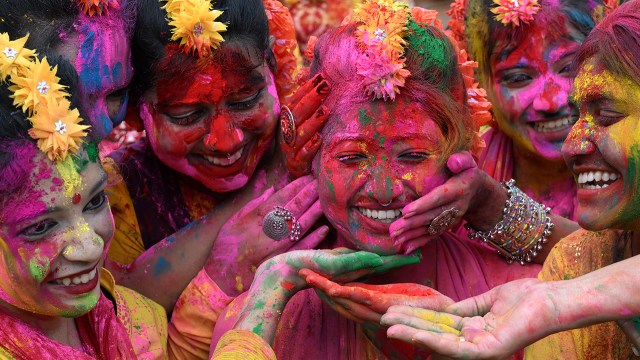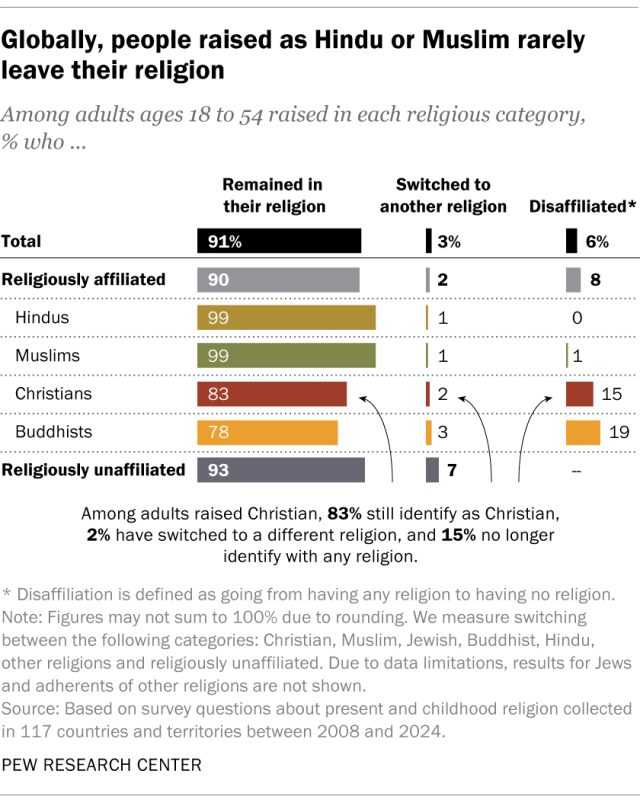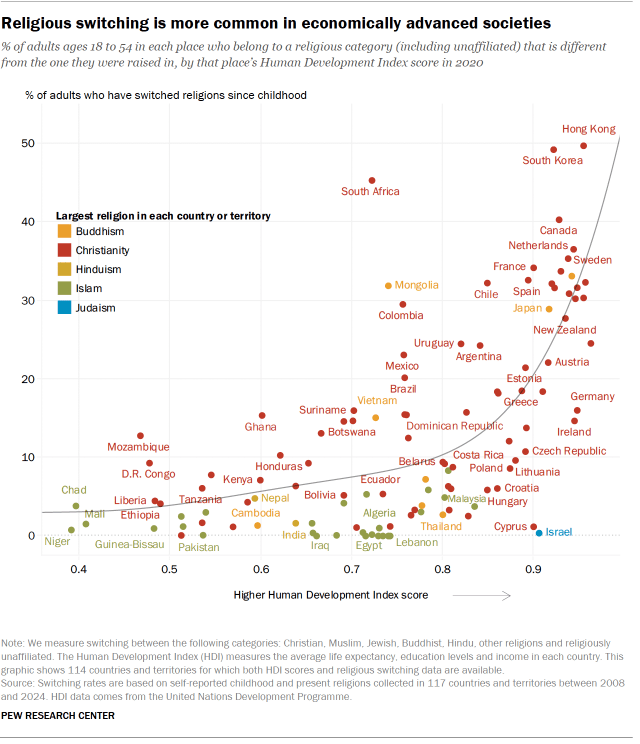
As of 2020, people who identify with a religion make up about 76% of the world’s population, according to a new Pew Research Center study on global religious change. This is down by about 1 percentage point from 2010. The decline is largely due to people shedding their religious identity after having been raised in a religion.
Globally, among adults under 55 who were raised in a religion, an estimated 10% have since switched, either to a different religion or to identifying with no religion.
To understand the global patterns of “switching” into and out of each religious category, we analyzed surveys from 117 countries and territories that cover 92% of the 2010 global population. Although religious switching may occur at any age, it is more common to experience as a young adult. Therefore, this analysis focuses on survey respondents ages 18 to 54 to look at more recent global switching patterns.
We discuss religious switching for Christians, Muslims, Buddhists, Hindus and the religiously unaffiliated. We also analyzed results for Jews and members of other religions, but they are not shown separately in this post because of their small sample sizes.
The “Religiously unaffiliated” category includes people who say they are atheist, agnostic or “nothing in particular” in response to a Pew Research Center survey question about religious identity. It also includes people who choose a “No religion” or “None” option in other surveys and national censuses.
Below, we explore the following key questions about religious switching around the world:
- How common is it for people to stay in or leave their childhood religion?
- Which religious category do people most commonly switch into?
- Which religious category has grown or shrunk the most from religious switching?
- What types of countries have the most religious switching?
How common is it for people to stay in or leave their childhood religion?

Globally, 91% of adults ages 18 to 54 say they still belong to the religion – or nonreligion – in which they were raised. This is sometimes referred to as “retention.” However, the share of people who retain their childhood religious identity in adulthood varies across religious categories.
Hindus and Muslims have the highest retention rates at 99% each. Just 1% of 18- to 54-year-olds who were raised Hindu or Muslim have switched out of the groups.
Among adults who were raised religiously unaffiliated, 93% still do not identify with any religion.
Christians – the world’s largest religious group – are less likely to retain their religion. About 83% of adults raised Christian are still Christian.
Buddhists have the lowest retention rates among the religious categories we studied. Fewer than eight-in-ten adults who were brought up as Buddhists (78%) have retained their religion.
Which religious category do people most commonly switch into?
Most religious switching around the world is disaffiliation – people leaving their childhood religion and no longer identifying with any religion.
Buddhists and Christians are the religious groups with the highest shares of people becoming religiously unaffiliated. For example, 19% of adults who were raised Buddhist no longer identify with any religion. Another 3% now identify with a different religion.
In contrast, it’s more common for people who were raised Hindu and Muslim to join a different religion than to identify with no religion.
Among adults who were raised without a religion, 7% of them have adopted a religion since childhood.
Which religious category has grown or shrunk the most from religious switching?
How switching affects the size of each religious group depends not only on retention, but also on how many people have joined the group.

Christians experienced the greatest overall losses due to religious switching. For every 100 adults ages 18 to 54 who were raised Christian, 17.1 left and 5.5 joined, resulting in a net loss of 11.6 people.
Buddhists had the highest rate of people leaving the religion (22.1 per 100 people raised Buddhist) among the groups we studied. But their rate of people joining is also relatively high (12.3). Taken together, Buddhists had the second-largest net loss from religious switching: 9.8 people for every 100 raised Buddhist.
The religiously unaffiliated had a net gain of 16.7 people for every 100 who were raised with no religion. That came from having the highest rate of people joining (24.2) and a moderate rate of people leaving (7.5).
Switching had little effect on the Muslim and Hindu populations because the modest rates of switching into and out of the religions roughly balanced out.
Religious switching fueled declines in the Christian and Buddhist populations between 2010 and 2020. The Christian share of the global population fell by 1.8 percentage points, and the Buddhist share dropped by 0.8 points.
What types of countries have the most religious switching?
Around the world, religious switching is more common in places that score higher on the United Nations’ Human Development Index (HDI), which measures average life expectancy, education levels and per capita income. In 51 places with HDI scores of 0.8 or greater – which the UN considers a “high” score – a median of 18% of 18- to 54-year-olds have switched religions.
In countries with low HDI scores, on the other hand, changing religions is rare. In the 16 countries with HDI scores below 0.55, which the UN considers a “low” score, a median of 3% of 18- to 54-year-olds have left their childhood religion.
However, economic development does not perfectly align with rates of religious switching, as several countries across the range of HDI scores have low rates of switching. This includes many Muslim-majority countries and Buddhist-majority Thailand and Cambodia.
In some countries with low rates of religious switching, laws restrict citizens from leaving their religion. For example, Algeria, Brunei, Egypt and Malaysia have laws penalizing citizens for leaving Islam for a different religion. Many states in India also have anti-conversion laws.

